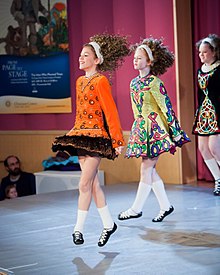Irish Stepdance
| Irish step dance | |
|---|---|

Irish dancers performing at a show
|
|
| Medium | dance |
| Types | performance and competition |
| Ancestor arts | Irish dance |
| Originating culture | Irish |
| Originating era | mid-1800s to present |
Irish stepdance is a style of performance dance with its roots in traditional Irish dance. It is generally characterized by a stiff upper body and quick and precise movements of the feet. It can be performed solo or in groups. Aside from public dance performances, there are also stepdance competitions all over the world. These competitions are often called "Feis'" which is short for Feiseanna. In Irish dance culture, Feisenna is a traditional Gaelic arts and culture festival. Costumes are considered important for stage presence in competition and performance Irish stepdance. In many cases, costumes are sold at high prices and can even be custom made. Males and females can both perform Irish stepdance but for the most part in today's society, the dance remains predominantly female. This means that the costumes are mainly dresses. Each dress is different, with varying colors and patterns, designed to attract the judges eye in competitions and the audiences eye in perfomance. General appearance besides the costume is also equally important. Many dancers invest in curled wigs that match their hair color but add to the effect of a traditional Irish dancer. Poodle Socks are worn with the dresses and shoes. These are white socks that stretch to mid calf with ribs in them to keep the strings of the shoes tied up on the leg.
Riverdance, an Irish stepdancing interval act in the 1994 Eurovision Song Contest that later became a hugely successful theatrical production, greatly contributed to its popularity. Once Riverdance became a large production, it changed the way that Irish dance was performed and viewed. Now that entrepreneurs could capitalize on Irish culture, they were able to tweak it to the audiences liking. This meant adding theatrical flair to the performance, including arm movements (as opposed to the previously rigid top half that dancers maintained) as well as sexualizing the dance and the costumes. To many this was a betrayal of tradition, but to some it was a way of expanding Irish culture and became widely accepted. Following after Riverdance was Lord of the Dance and many other theatrical productions based on Irish stepdance. Michael Flatley, an Irish stepdancer, became a well known name within these shows.
Two types of shoes are worn in Irish stepdance; hard shoes, which make sounds similar to tap shoes, and soft shoes (called Ghillies), which are similar to ballet slippers. The dances for soft shoe and hard shoe are generally different and go by different names. Different music with varying beats are played based on the dance, though they all share basic moves and rhythms. Most competitive stepdances are solo dances, though many stepdancers also perform and compete in traditional set and céilí dances. Competition is organized by several organizations, and there are competitions from the local level to world championships.
...
Wikipedia
